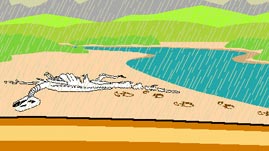Teachers' Domain - Digital Media for the Classroom and Professional Development
User: Preview

Source: University of California Museum of Paleontology
Remains and traces of ancient life are preserved in rock as fossils. This fossil record is a natural documentation of the evolution and history of life on Earth. In this interactive resource adapted from the University of California, Berkeley, Museum of Paleontology, see an animation about how organisms, such as dinosaurs, become part of the fossil record.
Fossils — the remains and traces of organisms that have been preserved through time — are a key source of information for understanding the history and development of life on Earth. Once buried within thick layers of rock, fossilized remnants of plants and animals help scientists piece together a picture of geologic time. The fossil record is like a diary of Earth, offering a glimpse into past conditions that have been preserved in chronologically sequenced rock formations.
Fossilization only happens under particular circumstances. When an organism dies, it is exposed to a variety of biotic and abiotic factors. Biotic factors, such as scavengers, predators, and decomposers, can break down and destroy the organism. Abiotic factors, including weathering, erosion, and tectonic processes such as volcanic activity and earthquakes, can also wear away or obliterate its remains. Thus organic matter left exposed to air and microorganisms quickly decomposes, and soft tissue, muscle, and organs do not generally become fossilized. However, hard, inorganic matter made of minerals, like bones and teeth, stands a better chance of being preserved, especially once it is buried under sediment. Over a long period of time, as the material slowly decays, it can be infused with minerals dissolved in ground water and become a fossil. Since the object is now composed of hard minerals, it maintains its original shape.
Not every type of rock contains fossils, so paleontologists — scientists who study fossils — focus their discovery efforts on areas with the type of rock most likely to contain them: sedimentary rock. Sedimentary rock is formed by the deposition of new layers over time. As each new layer is added, the remains of organisms from previous time periods end up farther and farther from Earth's surface. However, movement and interaction of Earth's lithospheric plates eventually moves fossils around, enabling their discovery. For example, in a process called uplift, deeply buried geological strata may be forced upward to the surface. Once close to the surface, fossils in these deposits may be excavated or, as is often the case, uncovered by the processes of erosion.
 Loading Standards
Loading Standards Teachers' Domain is proud to be a Pathways portal to the National Science Digital Library.
Teachers' Domain is proud to be a Pathways portal to the National Science Digital Library.
